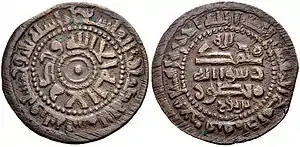Al-Muti
Abū ʾl-Qāsim al-Faḍl ibn al-Muqtadir (914 – September/October 974), better known by his regnal name of al-Mutīʿ li-ʾllāh (Arabic: المطيع لله, lit. 'Obedient to God'[1]), was the Abbasid caliph in Baghdad from 946 to 974, under the tutelage of the Buyid dynasty.
| al-Mutīʿ li-ʾllāh المطيع لله | |
|---|---|
| Khalīfah Amir al-Mu'minin | |
 | |
| 23rd Caliph of the Abbasid Caliphate Abbasid Caliph in Baghdad | |
| Reign | 28 January 946 – 4 August 974 |
| Predecessor | Al-Mustakfi |
| Successor | At-Ta'i |
| Born | 914 Baghdad |
| Died | September/October 974 (aged 60) Dayr al-Aqul |
| Issue | Al-Ta'i |
| Dynasty | Abbasid |
| Father | Al-Muqtadir |
| Mother | Mash'ala |
| Religion | Sunni Islam |
Biography
Early life
The future al-Muti was born al-Fadl, a son of Caliph al-Muqtadir (r. 908–932) and a Slavic concubine, Mash'ala. He was the brother of caliphs al-Radi (r. 934–940) and al-Muttaqi (r. 940–944).[2]
Harbouring designs on the throne, he was bitterly opposed to his uncle, al-Mustakfi (r. 944–946). The latter tried to capoture him, but al-Fadl eluded his agents and went into hiding; the caliph had to satisfy himself with demolishing his house.[1] On the news of this, the veteran vizier, Ali ibn Isa, is said to have remarked that "This day he [al-Fadl] ha sbeen acknowledged heir to the throne".[1] When the Daylamite Buyids under Mu'izz al-Dawla (r. 945–967) seized Baghdad in December 945, al-Fadl emerged from hiding and urged Mu'izz al-Dawla to depose al-Mustakfi, which was done in January or March 946.[2]
Caliphate
The Buyids and their followers were Shi'a sympathizers, and Mu'izz al-Dawla toyed with the idea of deposing the Abbasids outright and installing an Alid on the throne of Baghdad, or recognizing the Isma'ili Fatimid caliphs. He was dissuaded by his secretary, Abu Ja'far al-Saymari, who pointed out that in a clash between himself and a Shi'a caliph, the Daylamite soldiery were likely to side with the latter. Instead, Mu'izz al-Dawla raised al-Fadl to the caliphate, with the regnal name of al-Mutīʿ li-ʾllāh ("Obedient to God").[1]
Although of a sickly disposition, under Buyid tutelage al-Muti reigned as caliph for over 28 years, in stark contrast to his short-lived predecessors.[2][3] He was a weak figure, for all intents and purposes a puppet ruler of the Buyids, first Mu'izz al-Dawla, and then his son, Izz al-Dawla (r. 967–978). In theory, the Buyids and all their officials acted in the name of the Abbasid caliph. In practice, he was deprived of any meaningful authority, even over the choice of the officials of his household. In exchange for being allowed to lead a comfortable and secure life in the vast caliphal palaces, with daily salary of 2,000 dirhams, al-Muti provided legitimacy to the upstart Buyid regime in the eyes of the Muslim world.[2][4] A grandson of al-Muktafi (r. 902–908) rebelled in Armenia in 960 and claimed the caliphate as al-Mustajir Billah before being defeated,[3] while in 968, the rival candidacy of Muhammad, a son of al-Mustakfi, gathered considerable support in Baghdad, as well as by the Ikhshidid court in Egypt.[3]
The position of the Abbasid caliphs declined during his tenure: until 955, the Samanids of Khurasan refused to acknowledge his caliphate, while in the west, the rival Isma'ili Shi'a Fatimid Caliphate was growing more and more powerful,[2] conquering Egypt in 969 and beginning its expansion into the Levant.[5] Even in Baghdad, the pro-Shi'a sympathies of the Buyids meant that Shi'a influence was growing, and many Shi'a practices were introduced in the city, while Sunni and Shi'a partisans clashed in the streets.[2] As a result, al-Muti himself barely figures in the chronicles of his reign, and medieval historians generally considered his reign as the lowest ebb of the Abbasid Caliphate.[2]
In July 974, the Turkic general Sabuktakin managed to seize Baghdad from Izz al-Dawla, and seemed on the verge of overthrowing Buyid control over Iraq altogether; until reinforcements from the other Buyid rulers defeated the Turks in January 975.[6] During Sabuktakin's rule in the city, al-Muti was incapacitated by a stroke in August, and was forced to abdicate and was replaced by his son Abd al-Karim, as al-Ta'i (r. 974–991).[2][7] He died shortly after, in September/October 974, at Dayr al-Aqul.[2]
References
- Bowen 1928, p. 392.
- Zetterstéen & Bosworth 1993, p. 799.
- Donohue 2003, p. 263.
- Kennedy 2004, pp. 216, 239.
- Kennedy 2004, pp. 315–322.
- Kennedy 2004, pp. 223–224.
- Kennedy 2004, p. 224.
Sources
- Bowen, Harold (1928). The Life and Times of ʿAlí Ibn ʿÍsà: The Good Vizier. Cambridge: Cambridge University Press. OCLC 386849.
- Busse, Heribert (2004) [1969]. Chalif und Grosskönig - Die Buyiden im Irak (945-1055) [Caliph and Great King - The Buyids in Iraq (945-1055)] (in German). Würzburg: Ergon Verlag. ISBN 3-89913-005-7.
- Donohue, John J. (2003). The Buwayhid Dynasty in Iraq 334 H./945 to 403 H./1012: Shaping Institutions for the Future. Leiden and Boston: Brill. ISBN 90-04-12860-3.
- Kennedy, Hugh (2004). The Prophet and the Age of the Caliphates: The Islamic Near East from the 6th to the 11th Century (Second ed.). Harlow: Longman. ISBN 978-0-582-40525-7.
- Zetterstéen, K. V. & Bosworth, C. E. (1993). "al-Muṭīʿ Li 'llāh". In Bosworth, C. E.; van Donzel, E.; Heinrichs, W. P. & Pellat, Ch. (eds.). The Encyclopaedia of Islam, New Edition, Volume VII: Mif–Naz. Leiden: E. J. Brill. p. 799. ISBN 978-90-04-09419-2.
Al-Muti Born: 914 Died: September/October 974 | ||
| Sunni Islam titles | ||
|---|---|---|
| Preceded by Al-Mustakfi |
Caliph of Islam Abbasid Caliph January/March 946 – August 974 |
Succeeded by At-Ta'i |